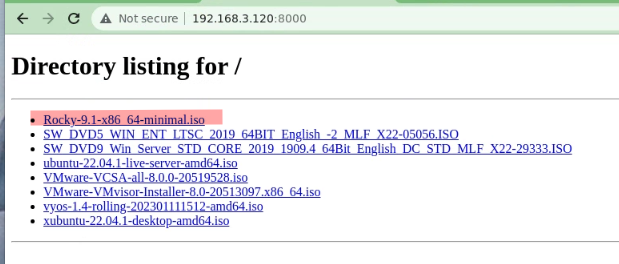Milestone 7 - Deploying and Post Provisioning of BlueX Linux Servers
💡In this module, we will be deploying 5 linux servers directly to a DHCP enabled BlueX LAN, adjusting network configurations similarly to the way we provisioned vyos. We will then adjust the networking configuration on 5 linux hosts. Adjust the number of deployed Linux systems if you are constrained in terms of memory.
7.1 Create a Rocky 9.1 Base VM
Create a Rocky Linux 9.1 Base VM from the minimal.iso file shown below, you should have enough information to make this happen. Make sure it is thin provisioned. The following script can be run to prepare the virtual machine.

7.2 DHCP Services on fw-blue1 and a static (or dynamic) route on 480-fw
- Create a static route on 480-fw such that 480-WAN traffic destined to the BLUE network IP space (10.0.5.0/24) is routed to the fw-blue1's eth0 interface
- Using an ansible playbook, create the DHCP pool on fw-blue1
- Demonstration video
- Using your version of 480-utils, create 3 rocky linked clones that land on the BLUE network, picking up a DHCP address.
- Demonstration video
Deliverable 1. Video demonstration of the use of your Get-IPs function to display the dhcp assigned ips of rocky 1 - 3. Walk through all documentation associated with 7.2.
7.3 Post Provisioning Rocky-1-3 with Ansible
Your ansible playbook should do the following:
- add a public key for the deployer user
- create a sudoers drop-in file for no password elevation to root by deployer
- change the hostname
- change the dhcp ip address to static (10.0.5.10,11,12)
Demonstration video
Deliverable 2. Video demonstration showing successful ansible run for post provisioning of Rocky 1-3. Walk through your playbook and inventory file for this part of the deliverable
7.4 Post Provisioning Ubuntu 1-2 with Ansible
Repeat the 7.3 requirements with ubuntu.
Deliverable 3. Video demonstration showing successful ansible run for post provisioning of Ubuntu 1-2. Walk through your playbook and inventory file for this part of the deliverable. Use static IP addresses of 10.0.5.30 and 10.0.5.31 for Ubuntu 1 and 2 respectively.
- Hint, I've found that templating the netplan configuration with jinja works well.